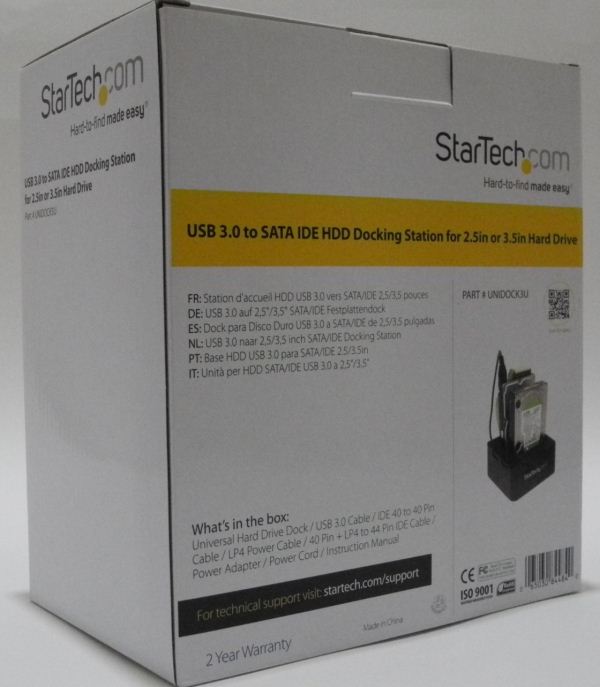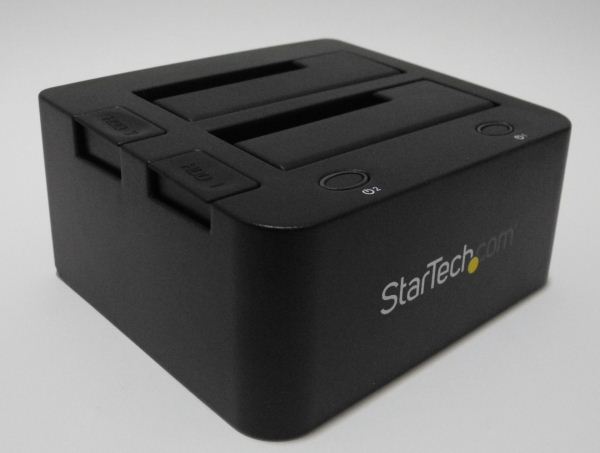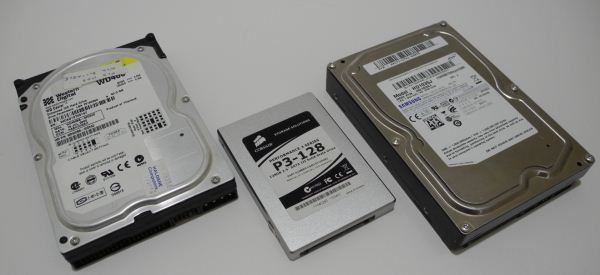StarTech.com USB 3.0 to SATA IDE HDD Docking Station Review
by Ganesh T S on June 18, 2012 1:30 PM ESTStarTech.com specializes in gadgets performing niche, yet handy functions. We reviewed their portable SATA duplicator last year, and this time around we have another interesting gadget from their stables. SATA and IDE hard drive docks / enclosures are a dime a dozen. However, the combination of features provided by the StarTech.com USB 3.0 SATA/IDE HDD docking station persuaded us to get a unit in-house for evaluation.
The unit supports upright docking of up to two disks (one SATA and one IDE). Both 2.5" and 3.5" drives can be used. Simultaneous access to both slots is also allowed. USB 3.0 (backward compatible with USB 2.0) is the only mode of communication between the PC and the dock.
Apart from the main unit pictured above, the package comes with the following components:
- 36W switching adapter with US power cord
- 1 x 3ft. USB 3.0 A Male to B Male cable
- 1 x IDE 40 to 40-Pin Cable (for 3.5" IDE drives)
- 1 x LP4 Power Cable (for 3.5" IDE drives)
- 1 x 40-Pin + LP4 to 44-Pin IDE Cable (for 2.5" IDE drives)
- Instruction Manual
For the purpose of testing out the unit, we used the following drives:
- Western Digital Caviar WD400 40GB IDE HD WD400BB-00DEA0
- Samsung HD103SJ 1000 GB 7200rpm SATA HD
- Corsair Performance 3 Series SATA III SSD CSSD-P3128GB2
While the WD and Corsair units were used for testing performance, the Samsung unit was used to check up on the power consumption profile of the unit under typical operating conditions. The Corsair SSD was also securely erased prior to the benchmarking in order to restore it to the optimum performance level. The IDE drive wasn't recognized with the jumper settings in Slave mode. Removing the jumper completely enabled access to the drive.
On the host side, we used our Ivy Bridge HTPC setup based on the Asus P8H77-M Pro motherboard. The H77 chipset provides native USB 3.0 and this rules out any performance limitation on the testbed side. The full specifications are provided below.
| StarTech.com USB 3.0 to SATA IDE Docking Station Testbed Setup | |
| Processor | Intel Core i7-3770K - 3.50 GHz (Turbo to 3.9 GHz) |
| Intel HD Graphics 4000 - 650 MHz (Max. Dynamic Frequency of 1150 MHz) | |
| Motherboard | Asus P8H77-M Pro uATX |
| OS Drive | Seagate Barracuda XT 2 TB |
| Secondary Drives | Kingston SSDNow V+ 128 GB SATA II SSD SNV325-S2/128GB |
| Corsair Performance 3 Series SATA III SSD CSSD-P3128GB2 | |
| Memory | G.SKILL ECO Series 4GB (2 x 2GB) SDRAM DDR3 1333 (PC3 10666) F3-10666CL7D-4GBECO CAS 9-9-9-24 |
| Case | Antec VERIS Fusion Remote Max |
| Power Supply | Antec TruePower New TP-550 550W |
| Operating System | Windows 7 Ultimate x64 SP1 |
| Display | Acer H243H |
| . | |
Note that the Asus P8H77-M Pro motherboard has USB 3.0 Boost, which can be used to improve the performance of storage devices connected to its USB 3.0 ports. In the Turbo mode, the BOT (Bulk Only Transport) protocol is used to improve performance (and is supported by all USB devices). USB 3.0 boost can also operate in UASP (USB Attached SCSCI Protocol) mode if the controller on the device side supports it. UASP allows multiple commands to be in transit between the host and the device at any given point of time.
For the purpose of our testing, we operated in default mode (without Turbo or UASP). This should give us an idea of the minimum performance level which can be obtained from the unit. However, we will also see whether Turbo or UASP mode makes any difference to the benchmark numbers.














17 Comments
View All Comments
sheh - Tuesday, June 19, 2012 - link
Cables running to the back? What's the idea?FH123 - Tuesday, June 19, 2012 - link
Due to bad experiences with products like these, my first question would be more fundamental than the benchmarks: Does it work reliably? I've had multiple enclosures from Akasa which plain didn't. They consistently caused CRC errors when validating Ghost backups. This happened with multiple units on multiple machines with backups that were subsequently verified to be good, when the drive was put directly into a machine. As far as I recall I even tried different hard drives. In other words, I ruled out that it was anything but the enclosure as best I could. Did you validate data integrity or did you just take that as a given?I also own an older eSata version of the StarTech product you reviewed, but never really used it because of the pungent smell from of my particular unit, perhaps from the soldering job. Can you report on the smell of yours? No, I'm not kidding, the smell of mine is really strong and I swore off StarTech units as a result.
A still different adapter that I own, while mostly working fine, causes backups to hang every so often.
The common thread with many of these products seems to be JMicron chipsets. It seems impossible to avoid them. Ever since Anandtech reported on the JMicron issues with the first OCZ SSDs, of which I owned one, I've become weary of that company. My GigaByte motherboard works very reliably, except every now and then, after a boot, the mouse cursor locks up at regular intervals. This was improved, but not eliminated, by updating a JMicron driver for the PATA chipset in the machine.
ganeshts - Tuesday, June 19, 2012 - link
We do not take data integrity as a given. I have actually used the unit to back up a couple of IDE (40 GB) and SATA drives (256 GB SSD / 1 TB HDD) sector-by-sector using HDDGuru's Raw Copy Tool : http://hddguru.com/software/HDD-Raw-Copy-Tool/ : and I had no trouble mounting the copies as virtual drives and accessing the data as well as restoring it back to the drive using the same software / docking station.My review unit didn't have any specific smell, but I really can't vouch for every unit out there.
JMicron's chipsets are cheap and quite common. SSD controllers are a different beast because there is no single right way to perform the activities of a SSD controller. SATA and USB bridges are fairly straightforward and it is just a matter of implementing the specifications. Note that the IDE bridge in this product has been around since early 2004 and the USB3 bridge has been around since late 2009. Plenty of time for customers to report issues with the chipsets and get it fixed in a new tape out / firmware update.
Aikouka - Tuesday, June 19, 2012 - link
I own two USB 3 HDD docks (single drive only) from Vantec, and they work rather well. However, there's one small annoyance that I have with them... the drives will sometimes vibrate. Since I have mine positioned on top of my tower, the resonance with my case makes a rather annoying buzzing noise. I usually solve this by shoving something in the slot with the drive.Does this enclosure suffer from the same problem?
Also, what made you want to review this enclosure over the numerous other brands? I know when I was searching for a new USB 3 enclosure, I saw a few different brands. I'm also curious... I noticed the Apricorn self-powered USB 3 SATA adapter, and I was wondering how that compares to a powered adapter. I think Anand used one in a recent review.
What's amusing is that I considered buying it, but I shied away because I had never heard of the brand Apricorn before. I bought a Crucial M4 SSD with the transfer kit (the normal one went OOS). I like having spare adapters, so I didn't mind too much. Well, I opened the box to find... an Apricorn adapter. It actually works rather well so far with my old SSD, which makes me rather bummed that I passed on them so quickly.
ganeshts - Tuesday, June 19, 2012 - link
There is no specific vibration dampening mechanism, but I really didn't encounter anything out of the ordinary. (Every dock I have seen has some amount of vibration, and it actually depends on the drive being used).As for why this kit was reviewed, it basically depends on what product a company pitches to us at a given point in time (whether it is relevant to our readers / current coverage) and whether the editors have time to review the product at the time of pitching :)
If you want us to review any particular brands, let us know and we can always try to approach them for evaluation units.
Lerianis - Tuesday, June 19, 2012 - link
Even server farms have swapped them out. Sounds to me like it would have been better to have both slots SATA so you can use both of them for hard drives.vectorm12 - Tuesday, June 19, 2012 - link
In Sweden you can pick one of those up but instead of StarTech it's branded deltaco. Wonder if it's just some gadget that's been labeled god knows what or if it's the same company using different names.